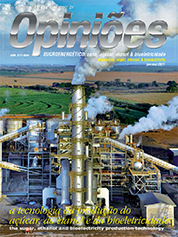Lorenzo Reynals Berdala
Director of M&M LabTest
Op-AA-27
The predictive maintenance market
Five years ago, I participated in a special edition of Revista Opiniões in a theme block on predictive maintenance, in which I emphasized its importance and the real gain perspectives for the sugar-based energy industry. Nowadays, the advancements and conquests that this system achieved in the industry, in comparison with the reality of that time, are quite evident.
Most certainly, maintenance concepts evolved to a higher level, at which practically all actions and definitions about investments directly influence predictive techniques. Competition, market, the influence of investor companies – some of which, until recently, even had no involvement or participation in the sugar-based energy industry –, among other factors, were determinant for the development of maintenance activity inside industrial companies.
It is also important to emphasize that the entry of professionals from other industries no doubt brought new visions and knowledge from their fields of origin. The adaptation of such concepts to the reality of the sugarcane-based energy industry, along with the complex knowledge developed over so many years within the industry itself, led the importance of predictive maintenance to an even higher level.
What I have observed in sugarcane-based energy industry companies, generally speaking, is the synergy that takes place among managers of large companies and the department responsible for predictive maintenance, due to the trust built up through the results achieved with its techniques. Each day, decision making is increasingly sustained on the reliability of information contained in predictive maintenance reports.
As this experience developed, the sugar-based energy industry became more demanding in selecting suppliers of maintenance tools and equipment. These, in turn, pressured and encouraged by development, began investing in the improvement of products and services they supply.
The market is signaling a safe, growing, and attractive development potential, as shown by growth in production of the current industrial units, due to the modernization of their installations and the coming on stream of new units throughout Brazil and in other countries. I would like to stress the importance of related predictive techniques, since one has provenly obtained better results in the analysis of diagnostics.
Hence, the directing and programming of any and all actions to be undertaken have taken place in a more efficient manner, given that predictive maintenance is based on the principle of anticipating its occurrence, assessing the performance of monitored equipment, while projecting perceived trends based on analyses and symptoms.
There are reports of cases in which projects and processes were reviewed based on conclusive opinions drawn up as the result of applying predictive techniques. Evidently, this is only possible if based on initiatives undertaken in a periodic and constant manner, involving the participation and commitment of the entire staff of industrial departments. This is the key aspect of the issue.
Is the predictive maintenance concept actually being properly applied in companies that use such techniques? Are we getting from them all they can provide us? I know of many units in Brazil and Central America in which such work is being performed in a serious and objective manner.
They created a culture and developed it inside their industrial plants, purchased equipment, allocated and hired professionals to exclusively perform this task, formalized partnerships with service providers, thereby achieving the results that justify all such effort. They assessed, analyzed, believed in, and decided to invest in the concepts of predictive maintenance. It is very important to check out and identify the root cause of defects.
Predictive maintenance directly influences such an investigation. However, in order for it to really be seen as a useful and precise tool, it is necessary that the service provider has the qualification, authorization and proven experience, and that, on the other hand, the company monitors the process through representatives empowered to make or influence decisions. Predictive maintenance will become increasingly more precise in light of the technological development of the equipment of diagnosis made available to that end, and the market will be expanded and sustained through the proven resulting returns.




